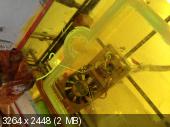a good way to make an ABS print stick better is taking some wasted ABS prints, cut it into small parts an solute it in acetone.
bring this solution onto your print surface with a brush an let it dry, now your first layer has a ABS bottom to stick on.
worked well for me with prints which kept refusing to stick to the heated bed














Recommended Posts
bingobob 0
OK, that print above turned out like this:
The warping in the support structure wasn't limited to the support structure, but you can see where the wall of the cylinder has pulled in.
I printed this part again but instead of having a fill ratio of 20% I used 100% and the the print was MUCH better. Much less deformation. Even on the support structure which is a bit odd.
I realised that the support structure on the right was more deformed than on the left and I realised it was due to the standard fan ducting which blows more air to that side of the print (the nozzle not being centered on the fan) so I have printed out a new duct that is much more directional to see if that helps:
Link to post
Share on other sites